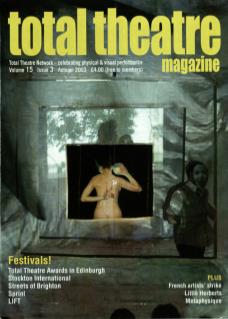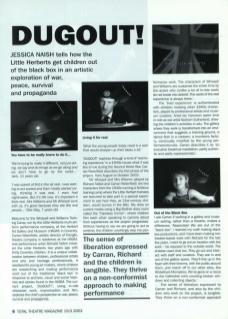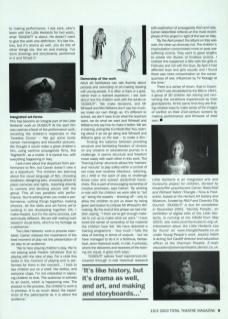You have to be really brave to do it...
'We're trying to make it different, not just acting, we say and do things as we go along and we don't have to go by the script...' Jack, 11 years old
‘I was scared at first in the air raid, I was starting to act scared and then I really started crying, thinking it was real. I even had nightmares. But it's OK now. It's important it feels real. Mrs Williams and Mr Whissell work with us, it's good because they are like real people...' Ellie May, 7 years old
Welcome to the Whissell and Williams Training Camp, run by the Little Herberts multi-artform performance company, at the Herbert Art Gallery and Museum (HAGM) in Coventry. Carran Waterfield, artistic director of Triangle, theatre company in residence at the HAGM, and performance artist Richard Talbot initiated the Little Herberts two years ago with thirty Coventry children. It is a unique collaboration between children, professional artists and arts and heritage professionals. A seedbed for young art makers, where children are researching and making performance work out of the traditional 'black box’ in response to archives, visual and social histories and stories found in the HAGM. The current project, DUGOUT!', using in-role character work, improvisation and film, explores the child's perspective on war, peace, survival and propaganda.
Living it for real
‘What the young people today need is a war! That would sharpen up their ideas a bit.’
DUGOUT! explores through a kind of real living experience in a 1940s house what it was like to live during the Second World War. Carran Waterfield describes the first phase of the project from August to October 2002:
‘Mr Whissell and Mrs Wiliams (played by Richard Talbot and Carran Waterfield) are two characters from the 1940s running a fictitious training camp where the Little Herbert trainees are recruited to take part in a special experiment to see how they, as 21st century children, would survive in the Blitz. We draw on current media using a Big Brother diary room called the "Careless Corner", where children film each other speaking to camera about their experiences as the project progresses. Without having to say we are going to act or pretend, the children unwittingly step into performance work. The characters of Whissell and Williams are sustained the entire time by the actors who (unlike a lot of in-role work) do not break into debrief. The world of the real experience is always there.’
The 'lived experience’ is authenticated with children meeting other 1940s characters, played by professional artists and museum curators. Artist Ian Cameron spent time in-role as war artist Graham Sutherland, drawing the children's activities in situ. The gallery where they work is transformed into an environment that suggests a training ground, a dance floor in a canteen, a munitions factory, continually modified by the young performers/recruits. Carran describes it as 'an evocative theatrical installation, partly authentic and partly expressionistic'.
Out of the Black Box
I ask Carran if working in a gallery and museum setting, rather than a theatre, makes a difference: ‘Absolutely! We are out of the "black box". I learned my craft making black box productions, and I have been making non theatre-based work with Richard for the last five years. I want to go out on location with the work – be exposed to the outside world. The children want that too. They go out and interact with staff and curators. They are in and out of the gallery space. They'll line up in the foyer with their brooms, with the public around them, and march off to our other sites, like Whitefriars Monastery. We've gone on a recce to the Cathedral ruins counting broken windows and collecting objects.’
The sense of liberation expressed by Carran and Richard, and also by the children who work on the project, is tangible. They thrive on a non-conformist approach to making performance. I ask Jack, who's been with the Little Herberts for two years, what DUGOUT! is about. He doesn't want to give the work one definition: 'It's like history, but it's drama as well, you do lots of other things too, like art and making. I've done drawings and storyboards, performed in it and filmed it.'
Integrated artforms
Film has become an integral part of the Little Herberts' work on DUGOUT!. At the start film was used as a facet of the performance work, recording the children's responses in the ‘Careless Corner' – 'We got some lovely cameo monologues and beautiful pictures. We thought it would make a great children's film, using wartime propaganda films, like Nightshift, as a model. It is topical too, with everything happening in Iraq.’
I ask more about the departure from performance to film, but Carran doesn't view it as a departure: ‘The children are learning about the visual language of film, choosing locations, designing sets, choosing where to place cameras and lights, reporting directly to camera and devising pieces with the group. This all has parallels with performance. You're editing when you make a performance, cutting things together, making choices. All the skills and artforms we're working in are dovetailing together. OK, I make theatre, but it's the same process, just technically different. We are still making work based in visual texts, which is my heritage as a performer.’
The Little Herberts' work is process orientated. Carran stresses the importance of the lived moment of play not the presentation of (a) play to an audience:
‘We're here playing children's play. We're not playing adult theatre (whatever that is) playing with the idea of play. For a child this exists in the moment of playing and is performed for them in the moment... I hate to see children put on a shelf, like dollies, and everyone claps. I'm not interested in exposing children to that. The audience is witness to an event, which is happening now. The product is the process, the children's work is in process. It is as much about the experience of the participants as it is about the audience.’
Ownership of the work
Adult art facilitators can talk fluently about process and ownership of art-making residing with young people. It is often a hope or a goal, rather than a realised aspiration. I ask Jack about how the children work with the adults on DUGOUT!: 'We make decisions, and Mr Whissell and Mrs Williams don't say too much, we make our own things up. It's different to school, we don't have to do what the teachers want, we do what we want and Whissell and Williams only say how to make it better. We are in training, acting like it is World War Two, learning about it as we go along and Whissell and Williams gave us the task – to make a film.’
Finding the balance between providing structure and facilitating freedom of choices on any creative or educational journey is a challenge. It seems structure and freedom move easily with each other in this work. The ‘Training Camp' structure allows the trainers and ‘recruits' to play safely within a context of set rules and routines (blackout, rationing, etc.) AND in the spirit of play to challenge those rules and subvert adult/child hierarchies. This is part of encouraging ownership of creative processes, says Carran: 'By working in-role with the children we were able to "act up" being the experts – showing off – only to allow the children to put us down by being given permission to criticise Mr Whissell's film making. By the end of this phase we had children saying, "I think we've got enough material to cut up to make what we want." I have loved the sense of ownership of the material the children have felt. We have delivered a training programme – how much I hate the idea of training in terms of outputs – but we have managed to do it in a fictitious, fantastical, semi-historical world, in-role, in process, where the deliverers and receivers of the training are equal. It goes both ways.’
DUGOUT! splices ‘lived' experiences discovered through in-role historical research with exploration of propaganda then and now. Carran Waterfield reflects on the most recent phase of the project in light of the war on Iraq.
‘By the April project the attack on Iraq was over, the clear-up obviously not. The children's improvisation concentrated more on post-war suffering victims. They went to great lengths to create the illusion of limbless victims. I noticed this happened a little with the girls in February and not with the boys. By April it had affected boys and girls equally and I found there was more concentration on the consequences of war, influenced by TV footage at the time.’
There is a sense of return, that in Coventry, which was devastated by the Blitz in 1941, a group of 30 children are reliving and reinventing the conditions experienced by their grandparents. At the same time they are finding creative ways to make sense of the images of conflict on their 21st Century screens by making performance and film work of their own.
Little Herberts is an integrated arts and museums project for children, devised by theatre/film practitioners Carran Waterfield and Richard Talbot (Triangle / Nina & Frederick), based at the Herbert Art Gallery and Museum, funded by RALP and Coventry City Council. DUGOUT! is due for completion in November 2003. Identity Parade, an exhibition of digital stills of the Little Herberts, is running at the HAGM from May 2003; see www.coventrymuseum.org.uk Information about the Little Herberts can be found on www.triangletheatre.co.uk under Young People's work. Jessica Naish is Acting Out Cardiff director and education officer at the Sherman Theatre. E-mail: education@shermantheatre.demon.co.uk


